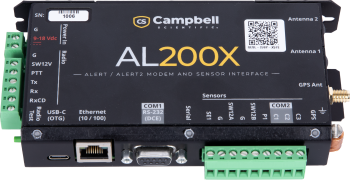Is a Game-Changing Upgrade in Your Future?
by Brett Hansen | Updated: 06/04/2025 | Comments: 0

As a hydrologist or emergency manager, do you need faster, more reliable, and higher resolution data from your flood warning system? If your current system uses the ALERT protocol, now may be the time to upgrade to a system that uses the ALERT2 protocol. In this article, I’ll explain the differences and the impact that upgrading can have for you.
As you know, flood warning systems are critical for public safety, especially as extreme weather events become more frequent and severe. For decades, Automated Local Evaluation in Real Time (ALERT) systems have been the backbone of many flood monitoring networks across the US and Australia. The ALERT protocol laid the foundation for collecting and transmitting rainfall and stream data quickly during storms.
As the demand for faster, more reliable, and higher resolution data grew, the limitations of legacy ALERT have become increasingly apparent. This paved the way for ALERT2, a modernized protocol that is transforming how emergency managers, hydrologists, and communities respond to flooding events.
Understanding the ALERT Protocol
The legacy ALERT protocol, developed in the late 1970s and early 1980s, revolutionized flood warning by enabling remotely located sensors to transmit data via analog UHF and VHF radios directly to base stations in real time. ALERT quickly became a standard for emergency management agencies and water resource departments.
While the legacy ALERT protocol was a major step forward in its time, it now poses several technical limitations for the flood monitoring networks of today:
- Slow transmission speed – ALERT operates at a relatively low baud rate (300 bps), which slows the rate of data delivery, especially when multiple sensors attempt to transmit simultaneously.
- Limited sensor ID pool – Only 8,192 unique IDs are available, restricting the number of deployable sensors in dense networks.
- Constrained data resolution – ALERT transmits data as an integer, limiting the value between 0 and 2,047, which restricts the granularity and precision needed for modern hydrologic analysis.
- Lost data – Because ALERT lacks collision avoidance and uses ALOHA-style communications, messages from different sensors can overlap, causing data loss during high-traffic events when receiving reliable data is most critical.
Advantages of the ALERT2 Protocol
The ALERT2 protocol was introduced in 2010 by the National Hydrologic Warning Council (NHWC), in association with the ALERT Users Group (AUG), as an answer to the growing limitations of legacy ALERT. It incorporates modern digital communications standards that significantly enhance performance and reliability.
Key benefits of ALERT2 include:
- Faster transmission speeds – ALERT2 supports up to 4,800 bps, reducing message time and allowing more sensors to transmit data in designated time slots.
- Larger networks – ALERT2 can accommodate 255 sensor IDs per site with 65,535 unique site identifiers—a theoretical total number of sensors greater than 16 million—vastly increasing the scalability of monitoring networks.
- Error-free data transport – Built-in forward error correction (FEC) ensures data integrity, even in challenging radio environments.
- Flexible data types – ALERT2 can accommodate multiple data types, including signed and unsigned integers, floating point, and timestamps.
- Time-synchronized transmissions – ALERT2 uses GPS time synchronization to eliminate message collisions, ensuring more consistent data during peak events.
These enhancements translate directly to improved data quality, higher reliability, and better situational awareness for emergency responders.
A real-world example of transitioning from ALERT to ALERT2 can be seen in the Texas: Transitioning to ALERT2 case study. Harris County Flood Control District (HCFCD) upgraded and installed 150 stations to ALERT2, significantly improving the system's data integrity from approximately 65% received transmissions with ALERT to 99.8% received transmissions with ALERT2 during critical flooding events.
Note: ALERT2 is a trademark of the National Hydrologic Warning Council.
Why upgrade to ALERT2?
Upgrading from ALERT to ALERT2 is more than a technical improvement; it’s a strategic investment in public safety. Here's why the switch is a game-changer:
- Better performance – Faster speeds and greater sensor capacity allow for denser and more detailed networks, providing real-time data that are both richer and more reliable.
- Reduced data loss – With time-synchronized messaging and error correction, ALERT2 nearly eliminates the issue of missed transmissions compared to ALERT during high-intensity events.
- Support for more data types – ALERT2 supports a broader array of environmental parameters, from precipitation and streamflow to wind and soil moisture, enhancing flood warning system capabilities.
- Operational efficiency – On the ground, emergency managers benefit from clearer, timelier information that allows them to make faster, better-informed decisions during flood emergencies. Technicians and network administrators also appreciate the simplified maintenance and diagnostic tools available in ALERT2-compatible systems.
A New Development
Campbell Scientific has been a world leader in providing robust and reliable weather monitoring systems since its inception over 50 years ago. Since 2014, Campbell Scientific has continued to provide ALERT and ALERT2 transmitters and customized solutions designed to meet customers’ specific needs. Continuing this tradition, Campbell Scientific is introducing the AL200X ALERT2 Modem and Sensor Interface, the successor to the AL200.

The AL200X continues the tradition of reliability with an expanded feature set:
- A modern processor and components ensure improved performance and interface relevance for many years to come.
- The expanded sensor and device input and output (I/O) enable you to install a cost-effective ALERT2 station, decreasing the expense of a typical flood warning system.
- With onboard data logging, the AL200X offers maintenance and troubleshooting activities without the need for an additional data logger.
- The Intelligent Network Device (IND) mode allows connection to a data logger for expanded sensor and telemetry device support.
For more information, visit the AL200X product page.
Conclusion
In a world where extreme weather events are becoming more frequent and severe, the importance of robust and reliable flood warning systems cannot be overstated. The ALERT2 protocol offers a leap forward in performance, reliability, and scalability over ALERT. For communities seeking to modernize their flood warning capabilities and protect lives and property, upgrading to ALERT2 isn’t just a good idea; it’s a necessary step into the future of hydrologic monitoring.
If you have any questions or comments, please post them below.
















 Brett Hansen is a Product Manager in the Environmental Group at Campbell Scientific, Inc., specializing in hydrology and flood warning solutions. He holds a degree in meteorology from the University of Utah and has a background in operational forecasting, weather system maintenance, installation, and design, as well as developing new sensors and solutions. In his spare time, you’ll find him in the backcountry hiking, running, camping, skiing, and capturing both the day and night through photography.
Brett Hansen is a Product Manager in the Environmental Group at Campbell Scientific, Inc., specializing in hydrology and flood warning solutions. He holds a degree in meteorology from the University of Utah and has a background in operational forecasting, weather system maintenance, installation, and design, as well as developing new sensors and solutions. In his spare time, you’ll find him in the backcountry hiking, running, camping, skiing, and capturing both the day and night through photography.
Comments
Please log in or register to comment.